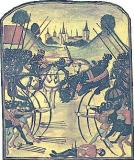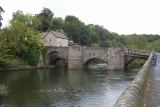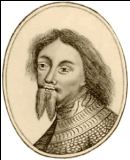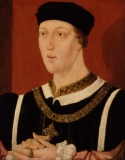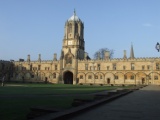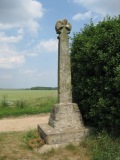A church of special significance for Richard, duke of York:
St Mary de Castro in Leicester
In March 2013, I spent a weekend in Leicester to attend the Richard III conference, but also used my time there to do some sightseeing. I was also lucky to be able to visit the church St Mary de Castro in Leicester. The word “lucky” is appropriate in this context, as visiting hours were limited. And in September 2013, the church had to close completely because of fears the spire might collapse [i] .it only reopened on 24 August 2014 [ii].
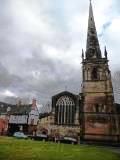
St Mary de Castro, from Castle Yard (© D Preis)
The limited visiting hours meant, I a short window of time before having to catch the coach back to Heathrow and the flight back to Australia, but I’m very glad that I did rush back to see it. It is a beautiful church and the people assisting visitors were incredibly friendly and helpful. I’m glad to see that mine was not an isolated experience, because a blogger remarked: “If it’s the same man who opens it up most days as the fellow who did on Saturday, you will get a warm and knowledgeable, but never overbearing welcome” [iii].
1. Early History
St Mary is the church of Leicester castle, hence the Latin ‘de Castro’; it was founded in 1107 as the chapel of the castle by Robert de Beaumont, who was created Earl of Leicester by King Henry I [iv]. Initially, the church was a college of 12 secular canons and a dean. However, it is possible that a Saxon collegiate church had existed on the site before the Norman conquest of 1066. A wall includes a stone, which might be a Saxon coffin lid and might have come from an earlier Saxon church.
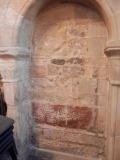
Possible Saxon coffin lid in St Mary de Castro (© D Preis)
Robert’s son, Robert le Bossu (the Hunchback), founded Leicester Abbey and called it ‘St. Mary de Pratis’ (St. Mary of the Meadows). It seems his own foundation was more important to him, as he endowed it with the properties, which up to that point had been set aside to provide St Mary De Castro with an income. However, a few years later the Abbot and the Earl restored the college, though on a smaller scale. At the same time, it also served as a parish church, which helped the financial situation of the church. While the college was dissolved by the Chantry Act of Edward VI in 1548, it continues to be a parish church to this day.
The first Norman church was much smaller than today’s building, only approx. 40m long, without a tower or spire and no glass in the windows. Some arches and the carving of a little figure, which might depict a page or a squire indicated by the kirtle and hairstyle, remain from the 12th century church.
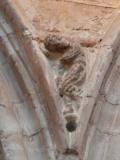
Little figure, possibly of a page or squire (© D Preis)
Then Robert de Blanchesmains, third Earl, the son of le Bossu, supported Queen Eleanor and her sons in their quarrel with Henry II, with the unfortunate result that the town was sacked in 1173 and the church severely damaged.
2. Rebuilding in the 12th century
Afterwards the church was rebuilt and in the process made longer and a chancel was built, possibly chapels were added on the sides.
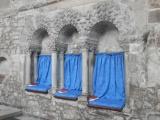
Norman sedilia (© D Preis)
Of interest are the sedilia (three seats for the priest and his helpers) in the south wall of the chancel. They are said to be among the finest examples of Norman work in the country, with double columns, fine chiselled decoration and characteristic chevron moulded round arches. There was also a piscina (stone basin), but this was mutilated at a later stage and only re-discovered with the aumbries (i.e. the cupboards “for to lay anything in pertaininge to the High Altar”), in the middle of the 19th century.
3. 13th century extension
By the early 13th century with the increased importance and size of the castle, it was decided to extent the church, by enlarging the south chapel, for the use of the parishioners. This aisle had its own altar, dedicated to the Holy Trinity. As a result there were basically two churches under one roof, separated by the original outside wall. The new church also has sedilia (these with pointed arches) and a piscina, built in the south wall, these are in the Early English style.
4. The tower
Possibly before 1300, the tower was fitted inside the church, as on the outside it would interfere with the passage between the castle’s gates in case of attack. In the area underneath the tower is the font. In this area some floor tiles from the 14th century are preserved. The spire was added in 1400 and partly rebuilt in 1685. However, it was discovered to be in a perilous state and was demolished in 2013/14. There is an appeal to raise money for a rebuilding of the spire.
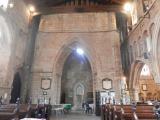
Tower inside the church (© D Preis)
5. Famous people with a connection to St Mary de Castro
St Mary De Castro has connections to a number of famous people. In the 14th century, the early dissident and translator of the Bible, John Wycliffe, preached at St Mary. The Lollards continued to have a strong hold in the Leicester area.
St Mary de Castro might be the church where Geoffrey Chaucer married Philippa de Roet, the sister of Katherine de Roet (Swynford), in the 1360s. Their great-grandson John de la Pole, second duke of Suffolk, married Elizabeth, a sister of Edward IV and Richard III, here in 1458. His parents were William de la Pole and Alice Chaucer, daughter of Thomas Chaucer, one of Geoffrey and Philippa’s children.
Katherine de Roet and John of Gaunt, who was also earl of Leicester from November 1362 onwards [v], are among the ancestors of both Edward IV and Richard III as well as the Tudors.
6. The Parliament of Bats
In 1426, the so-called Parliament of Bats was held in Leicester. This was a time of a power struggle between the chancellor, Henry Beaufort, bishop of Winchester, and the Protector, Humphrey, duke of Gloucester. As there was also a disagreement with the London mercantile community over tunnage and poundage, it was decided for parliament to sit in Leicester instead of London. John, duke of Bedford, returned from the war in France to resume his role as protector. The name ‘Parliament of Bats’ has nothing to do with flying mammals, but more with cricket bats. It refers to the lords’ retainers being armed with bludgeons, ‘battes’, although they had been instructed not to carry arms [vi].
At the time King Henry VI was only four years old. It was at St Mary de Castro that on 19 May 1426 Bedford knighted Henry VI, who in turn knighted 36 others. One of them was the then 14-year-old Richard, third duke of York (who was to become the father of Richard III) [vii]. We can only speculate that this must have been a very exciting event for the 14-year-old boy. Of course, at this time nobody could foresee the later disagreement between duke and king, which would lead to what is known today as the Wars of the Roses. All through this period the town was loyal to the Yorkists and send its forces to fight for Edward, Earl of March (later Edward IV), at Towton in 1461 [viii].
7. Richard III and Leicester
His son, Richard III, would have attended mass at St Mary de Castro. He visited Leicester [ix] several times before he became king and might very well have stayed at the castle. We know for sure that during his reign he stayed at the castle twice in 1483. During the first visit, 17 to 20 August, he wrote two letters “from my castle at Leicester”, which are extant. The second visit was 22/23 October, while assembling an army to fight Buckingham’s revolt. He also visited the town twice in 1484, but on these occasions does not seem to have stayed at the castle, which might have been in a poor state of repair by then. During his first visit of 1484, on 31 July, he visited Leicester Abbey and for the second, on 5 November, Edwards says in The Itinerary that he was at the “Town of Leicester”, though we do not know where. And of course, Richard stayed in Leicester 19-21 August 1485, before marching out to fight Henry Tudor’s army at Bosworth, supported by forces from Leicester. We do not know for sure where he stayed on this last occasion, though legend has it that he spent the nights at the Blue Boar Inn.
After his death, his body was displayed at St Mary-in-the-Newarke in Leicester, to show the people of the city who had supported him that he was dead indeed. In the meantime, Henry Tudor celebrated his victory at Coventry, where he stayed the night 24/25 August. Coventry citizens probably felt it was politic to welcome him lavishly, but in the city annals they recorded that King Richard “was shamefully Carryed to Leicester & Buryed their”[x] .
Notes:
i. ‘St Mary De Castro church shut for six months over spire collapse fear’, BBC News Leicester (7 September 2013). URL: http://www.bbc.co.uk/news/uk-england-leicestershire-23985692 Date accessed: 13 October 2013
ii. Home page of The Collegiate Parish Church of St. Mary de Castro, Leicester. URL: http://www.stmarydecastro.co.uk/ Date accessed: 10 October 2014
iii. James Alexander Cameron, ‘The medieval churches of Leicester and their many sedilia study trip’, Stained Glass Attitudes (16 April 2013).
iv. Information on the church:
‘The ancient borough: St. Mary’s’, A History of the County of Leicester: volume 4: The City of Leicester (1958), pp. 369-380. URL: http://www.british-history.ac.uk/report.aspx?compid=66579 Date accessed: 31 October 2013
Visitor’s Guide to St Mary de Castro
v. Simon Walker, ‘John , duke of Aquitaine and duke of Lancaster, styled king of Castile and León (1340–1399)’, Oxford Dictionary of National Biography, Oxford University Press, 2004; online edn, May 2008.
vi. ‘The Parliament of Bats, 4 Hen. VI’, The History of Parliament. URL: http://www.histparl.ac.uk/volume/1422-1504/parliament/1426 Date accessed: 12 January 2014
vii. Ralph Alan Griffiths, The Reign of King Henry VI: The Exercise of Royal Authority, 1422-1461. University of California Press, 1981, pp.80-81
viii. Mathew Morris & Richard Buckley, Richard III: The King under the Car Park. University of Leicester Archaeological Services, 2013, p.11
ix. For Richard III’s visits to Leicester see Morris & Buckley, pp.11-12; as well as Rhoda Edwards, The Itinerary of King Richard III 1483-1485. Richard III Society, 1983.
x. DeLloyd J Guth, “Richard III, Henry VII and the City: London Politics and the ‘Dun Cow’”, in: Kings and Nobles in the Later Middle Ages: a Tribute to Charles Ross, ed. by Ralph A. Griffiths & James Sherborne. Sutton, Gloucester, 1986, pp.194-195
Tags: Castles, Church, Henry VI, Leicester, Richard Duke of York, Richard III

